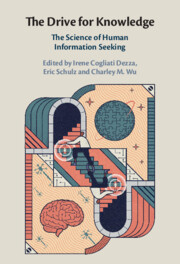Book contents
- The Drive for Knowledge
- The Drive for Knowledge
- Copyright page
- Contents
- Figures
- Tables
- Notes on Contributors
- Preface
- Part I What Drives Humans to Seek Information?
- Part II How Do Humans Search for Information?
- Chapter 5 What Makes a Good Query?
- Chapter 6 Active Inference, Bayesian Optimal Design, and Expected Utility
- Chapter 7 Exploration Beyond Bandits
- Chapter 8 Representational Exchange in Human Social Learning
- Part III Which Machinery Supports the Drive for Knowledge?
- Index
- References
Chapter 8 - Representational Exchange in Human Social Learning
Balancing Efficiency and Flexibility
from Part II - How Do Humans Search for Information?
Published online by Cambridge University Press: 19 May 2022
- The Drive for Knowledge
- The Drive for Knowledge
- Copyright page
- Contents
- Figures
- Tables
- Notes on Contributors
- Preface
- Part I What Drives Humans to Seek Information?
- Part II How Do Humans Search for Information?
- Chapter 5 What Makes a Good Query?
- Chapter 6 Active Inference, Bayesian Optimal Design, and Expected Utility
- Chapter 7 Exploration Beyond Bandits
- Chapter 8 Representational Exchange in Human Social Learning
- Part III Which Machinery Supports the Drive for Knowledge?
- Index
- References
Summary
What makes human social learning so powerful? While past accounts have sometimes prioritized finding the single capacity that makes the largest difference, our social learning abilities span a wide spectrum of capacities from the high-fidelity imitation of behaviors to inferring and learning from hidden mental states. Here, we propose that the power of human social learning lies not within a single capacity, but in our ability to flexibly arbitrate between different computations and to integrate their outputs. In particular, learners can directly copy the demonstrator’s actions in the absence of causal insight (policy imitation), infer their instrumental values (value inference), or infer their model of the world and intrinsic rewards (belief inference and reward inference). Each of these strategies trades off the cost of computation against the flexibility and compositionality of its outputs. Crucially, we have the capacity to arbitrate and exchange information between these representational formats. Human social learning, we suggest, is powerful not just because of the way it moves information between minds, but also because of the way it flexibly moves information within them.
- Type
- Chapter
- Information
- The Drive for KnowledgeThe Science of Human Information Seeking, pp. 169 - 192Publisher: Cambridge University PressPrint publication year: 2022
References
- 7
- Cited by

